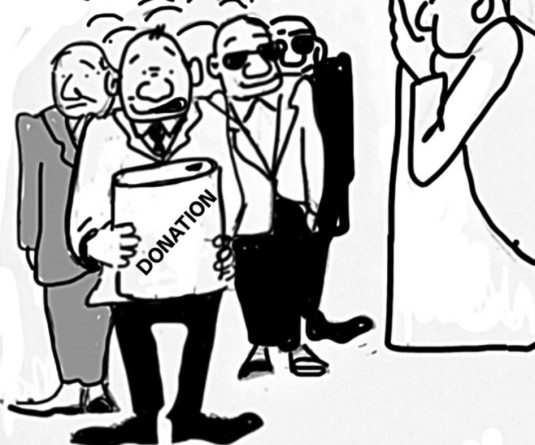People of Lower Chandmari in Kohima, faced with severe lack of water, have resorted to autonomous pipelines drawn from sources in the hills. Despite the tangles, each owner knows which pipe is theirs. These pipelines are old but supply irregular water at a high cost. The right to safe drinking water, meanwhile, continues to evade the people. (Morung Photo/Keren Rose)
Aheli Moitra
Dimapur | March 17
Nagaland’s water trouble is not just locally severe, it is widespread. For people closest to the capital to farthest, access to water remains wishful. The Department of Public Health and Engineering (PHE), meanwhile, finds itself in a conundrum. Where there is water, there is social conflict over it or no distribution mechanism; where there is no water, there is no technology for expansion.
The issue has been highlighted through the past few years yet no political will has been shown to resolve it. If the first session of the 12th Nagaland Legislative Assembly has somewhere to start on churning out ‘solutions’, the issue of water is it.
“PHE pipelines lie damaged for more than 10 years, but our complaints to the department have been met with silence,” grumbles Shongleng Phom, a resident of Longleng town. For more than 10 years, people from Longleng have been walking down to the river, and up, to collect water. The burden of this, like the rest of the global south falls on women; in sub-Saharan Africa, suggests UNDP data, women spend 40 billion hours per year, on an average, collecting water. This has given way to considerable activism for water and rights. In Nagaland, life goes on; where governance has lapsed, local suppliers have stepped in.
In Longleng, a wealthy family has bored a well on their land in the middle of town. They charge Rs. 600 per 1000 liters which most people cannot afford. This, while the PHE offers an attractive rate of Rs. 15 per 1000 liters for domestic use, apart from the initial investment in drawing pipes from a PHE sub reservoir to your tank. The story, as reported here before, in Mokokchung is no different, with people shelling out Rs. 500 per 1000 liters at times. The privatization, and thus inflation of price, of water is a cruel irony for people nestled in the midst of water with no real economy.
“The water pipes here were laid in the 1970s for 20-30 households at the time,” says John Semy, resident of Tseminyu town and general secretary of the Rengma Hoho. “Today there are 2000 households in the town with a population of 5000-6000 people who continue to survive on the same network of pipes,” he quips. Tseminyu’s population has a local truck ferrying up water from the upper part of the river (the town’s drains open up into the lower) for which residents pay around Rs. 400 per 1000 liters.
The Department has been trying to connect but opportunities, according to them, remain limited. The people’s hold over land is cited at the crux of the issue. In Dimapur the PHED is capable of supplying 3 million liters of water in a day. But they have been able to connect only 921 tanks (catering roughly 7500 people) in town to the grid as people do not allow for new pipes to pass through their compounds, placed as they are in a haphazard manner due to lack of planning. “We will propose a new scheme for metering (system of piping and gauging) that loops the pipes round colonies, running underneath roads to reach homes,” explains Er. Imtiakum, executive engineer of the PHED’s urban division in Dimapur. “There is no way to negotiate with the people,” he says.
The people, on the other hand, have no faith in governance so where they find ground water in abundance, they dig a well.
In the hills, an underground oasis is not easily struck. In contrast to its rich and powerful, Kohima’s citizens, faced with acute shortage, have gone autonomous and drawn their own pipes. The people are dependent on Kohima Village (T Khel) and Jotsoma village which own the water sources in the hills. It is said that Rs. 500 per line per month is charged for an irregular water supply. The PHED supplies water to 5000 consumers (40,000 people—less than half the population) in Kohima but water sources run dry in “off season” leading to 15% reduction in per capita supply (and thus consumption). PHE water in this season reaches some consumers once in 7 days.
Wokha has its share of twisted pipe scams. Mon has three water sources but due to its rugged topography and land disputes, pipes remain broken which the Department finds itself unable to repair.
The pipes are not strong enough, the government cannot intervene. If a social problem leads to water source dispute or pipe breakage, the government will not intervene. With communitisation, if a line man dies, the government does not intervene.
For the last 25 years, pumping systems (most locations being higher than source) in Nagaland have failed due to lack of electricity and economic infeasibility. For proliferating towns like Kohima, alternatives need to be negotiated. “We have an exigency plan in place since 2007, supplying water tankers to colonies at the rate of Rs. 278 per 1000 liters but without an alternative source, there is no hope for citizens,” says Er. Y. Tep, superintendent engineer, PHE Kohima Circle.
Where communitisation lags behind as a solution due to poorly empowered communities, the political leadership has to step in to put negotiations and systems in order. But the question remains: are they capable of it?





